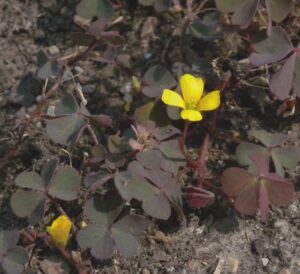
This common “weed”, Oxalis corniculata, found in Arkansas, has important medicinal usage reported in the Indian pharmaceutical codex, the Chinese, British and the American pharmacopoeias and in different traditional system of medicines such as Ayurveda, Unani and Siddha. Many recognize this as one of our wild edibles, the sorrels have a delicious lemony flavor. But it does so much more! Where to begin?
First of all, how to identify it. There are two color forms of Creeping Wood Sorrel. One color form has green foliage, while the other color form has purplish foliage, especially while growing in bright sunlight. Creeping Wood Sorrel is similar in appearance to two native species, Oxalis stricta (Yellow Wood Sorrel) and Oxalis fontana (Yellow Wood Sorrel). Neither of these two species produce creeping stolons, and they usually have a more erect habit of growth. Unlike the purple form of Creeping Wood Sorrel, the leaflets of Oxalis stricta and Oxalis fontana usually remain green in bright sunlight, although they sometimes develop a faint purplish tint.
Results from one study indicated that Oxalis corniculata could be an important dietary source of antioxidants with high scavenging abilities as well as rich in biomolecules that are precursors of most biologically active chemicals of medical importance. These findings may thus, justify their wide usage in traditional medicine.
Oxalis corniculata Linn. is highly used for its antioxidant, anti-fungal, anthelmintic, anti-inflammatory, analgesic, astringent, anti-cancer, depurative, diuretic, emmenagogue, anti-microbial, febrifuge, cardio-relaxant, lithontripic, stomachic and styptic properties worldwide.
Constituents
The entire plant is rich in vitamin C and β-carotene and has traditionally been used against scurvy. Other phytochemicals include flavanoids, tannins, phytosterols, phenol, glycoseides, fatty acids, galactoglycerolipid and volatile oil. It is rich source of essential fatty acids like palmitic acid, oleic, linoleic, linolenic and stearic acids.
Wound Care
This plant has traditionally been used to treat traumatic wounds, sprains and even poisonous snake bites. The leaf juice is applied to insect bites, burns and skin eruptions. It’s antibiotic so it helps prevent bacterial infection in wounds. In Zaire they make a paste of the whole plant for venomous snake bites to rub directly to the wound. Then they swallow the juice of the masticated plant. Another paste is made using salted Oxalis corniculata and Aframomum sanguineum (an African plant called Wild Cardamom, in the ginger family) , this is applied to the wound and its covered.
The extract of the plant is applied in case of scorpion sting. Fresh leaves of Oxalis corniculata are crushed and are used to stop bleeding from wounds.
The alcoholic and petroleum ether extract of whole plant of Oxalis corniculata has been evaluated for its wound healing activity by using excision, resutured incision and dead space wound models in rats. Both the extracts at the dose of 300 and 500 mg per kg. The result showed significant wound healing activity by producing an increase in wound contraction rate, wound breaking and significant decreases in epithelization period. (Taranalli AD, Tipare SV, Kumar S. Wound healing activity of Oxalis Corniculata whole plant extract in rats. Indian Journal of pharmaceutical sciences. 2004;66(4):444- 446. )
Wound Healing Activity Of Oxalis Corniculata Whole Plant Extract In Rats.
Antimicrobial
Methanolic and ethanolic extracts of Oxalis corniculata plant showed significant antibacterial activity against Xanthomonas and fourteen human pathogenic bacteria. Interestingly, among the extracts, Methanol extract showed highly significant activity as compared to K-cycline and Bact-805 against plant pathogenic bacteria. In case of human pathogenic bacteria methanol extract showed moderately significant antibacterial activity when compared with standard streptomycin. (Raghvendra MP, Satish S. Raveesha KA. Phytochemical analysis and antibacterial activity of Oxalis Corniculata, a known medicinal plant. My Science. 2006;1:72-78.)
Antifungal (Black Mold!!)
Black mold is a common problem in buildings. One study discovered it could suppress growth by 71-86%.
The aqueous extract of four various plants were evaluated for antifungal activity against various pathogens. All the four plants showed different activities against all the pathogenic fungi. Among them Oxalis corniculata showed the significant antifungal activity against A. niger (black mold) by suppressed the fungal mycelial growth by 71 to 86% after three days of incubation. The aqueous extract of Oxalis corniculata showed the 31 % antifungal potency against A. niger and 10.7% against P. theae (Verma RK, Chaurasia L, Katiyar S. Potential antifungal plants for controlling building fungi. Natural Product Radiance. 2008;7(4):374-387)
Poison Antidote
In addition to helping with snake bites, the leaves are used as an antidote to poisoning by the seeds of Datura spp., arsenic and mercury.
Skin Conditions
The leaves are effective in certain skin disease like warts, corns and other excrescences of the skin. They can be locally applied in these conditions. For warts, a poultice placed over warts ripens them, also juice of whole plant mixed with onion can be applied. A poultice of the leaves applied over an inflammation relieves pain, and when applied over boils, ripens them.
Liver & Digestive Problems
In Ayurvedic medicine, it is used for liver and digestive problems. In Nepal, it is used for stomachaches. Its well known for its medicinal value as a good appetizer and aid for dyspepsia. Boil the plant in butter milk for indigestion and diarrhea in children. A table spoon of fresh juice mixed with buttermilk made of cow’s milk can be taken once daily in the treatment of jaundice.
Support for the Heart
One study with an aqueous extract as a 30-day pretreatment in experimental myocardial infarction provided evidence that O. corniculata was found to be protecting the myocardium against ischemic insult and the protective effect could attribute to its antioxidative and antihyperlipidemic activities.
And that’s not all!!
Subscribe to the Ultimate Herbal Database for additional uses and information.
